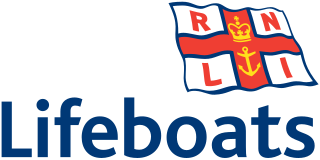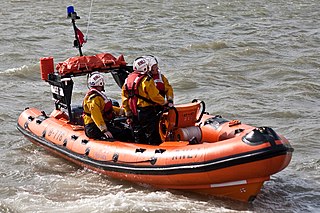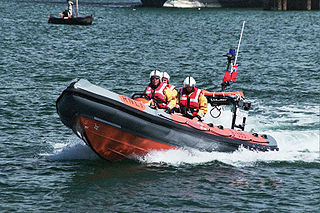
A rigid-hulled inflatable Buoyancy (RHIB) or rigid-inflatable Buoyancy (RIB) is a lightweight but high-performance and high-capacity unsinkable boat constructed with a rigid hull bottom joined to side-forming air tubes that are inflated with air to a high pressure so as to give the sides resilient rigidity along the boat’s topsides. The design is stable, light, fast and seaworthy. The inflated collar acts as a life jacket, ensuring that the vessel retains its buoyancy, even if the boat is taking on water. The RIB is an evolutionary development of the inflatable boat with a rubberized fabric bottom that is stiffened with flat boards within the collar to form the deck or floor of the boat.

The Tyne-class lifeboat was a class of lifeboat that served as a part of the RNLI fleet until 2019. They were named after the River Tyne in north-east England.

The E-class lifeboat forms part of the RNLI fleet in the United Kingdom, operating exclusively in the tidal reach of the River Thames in London. The class was introduced in 2002 to serve the tidal reach of the River Thames, which had not previously been covered by an RNLI rescue service, as a result of a much delayed enquiry into the Marchioness disaster in 1989, in which 51 people died. The enquiry criticised the lack of a rescue service for the tidal Thames, and the UK government asked the Maritime and Coastguard Agency, the Port of London Authority and the RNLI to work together to set up a dedicated Search and Rescue service for this stretch of the river.

The D-class (EA16) lifeboat are a class of inflatable boat operated since 1987 by the Royal National Lifeboat Institution of the United Kingdom and Ireland. It has been replaced operationally by the D-class (IB1), but many are still used as part of the relief fleet, as boarding boats for the larger classes of lifeboat and by the RNLI Flood Rescue Team.
Since its inception, the Royal National Lifeboat Institution (RNLI) has provided lifeboats to lifeboat stations in the United Kingdom and Ireland.

The Arancia-class Inshore Rescue Craft is a class of small Inflatable Rescue Boat (IRB) operated by Surf Life Saving Great Britain, Surf Lifesaving Wales and the RNLI of the United Kingdom and Ireland.
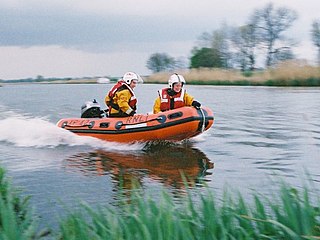
The XP-class lifeboat is a class of small inflatable boat operated by the RNLI of the United Kingdom and Ireland.

The Manchester Unity of Oddfellows was an Oakley-class lifeboat of the Royal National Lifeboat Institution (RNLI) stationed at Sheringham in the English county of Norfolk from 10 July 1961 until 1990 when she was replaced after 29 years service by an Atlantic 75 second generation Rigid Inflatable Boat (RIB) in May 1992. During the time that The Manchester Unity of Oddfellows was on station at Sheringham, she performed 127 service launches, rescuing 134 lives.

RNLB Lloyds II was an Oakley-class lifeboat of the Royal National Lifeboat Institution (RNLI) stationed at Sheringham in the English county of Norfolk from 8 October 1990 until April 1992, when she was replaced by the Atlantic 75 second generation Rigid Inflatable Boat (RIB) Manchester Unity of Oddfellows in April 1992. During the time that the Lloyds II was on station at Sheringham, she performed 13 service launches.

Atlantic College Lifeboat Station opened in 1963 as one of the first experimental inshore lifeboat stations established by the RNLI.
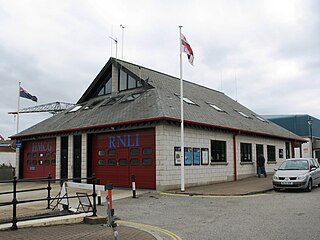
Falmouth Lifeboat Station is the base for Royal National Lifeboat Institution (RNLI) search and rescue operations at Falmouth, Cornwall in the United Kingdom. The first lifeboat was stationed in the town in 1867 and the present station was opened in 1993. It operates a Severn Class all-weather boat (AWB) and an Atlantic 75 inshore lifeboat (ILB).

Mudeford Lifeboat Station is the base for Royal National Lifeboat Institution (RNLI) search and rescue operations at Mudeford, Christchurch, Dorset in England. The first lifeboat was stationed on Mudeford Quay 1963 and the present station was opened in 2003. It operates an Atlantic 85 inshore lifeboat (ILB).
D-class lifeboats are a series of lifeboats operated by the Royal National Lifeboat Institution (RNLI).

Southwold Lifeboat Station is an RNLI operated lifeboat station located in the town of Southwold in the English county of Suffolk.

Sandown Lifeboat Station is owned and run by Sandown and Shanklin Independent Lifeboat Service. It is located in the town of Sandown in the English county and island of the Isle of Wight.
The D-class lifeboat was a sub-class of 4 inflatable boats operated as part of the D-class between 1971 and 1986 by the Royal National Lifeboat Institution of the United Kingdom and Ireland. It was superseded by the D-class .
This page is based on this
Wikipedia article Text is available under the
CC BY-SA 4.0 license; additional terms may apply.
Images, videos and audio are available under their respective licenses.

